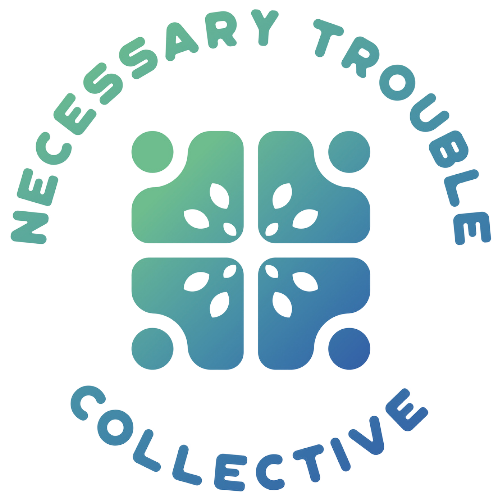What we mean by Nonviolence
When I meet people and tell them that I am learning and teaching Nonviolent Communication, they give me a bit of a strange look and then say “Congratulations, does that mean you are not swearing and yelling anymore?”. I realize that for many people, nonviolence means the absence of overt or obvious violence. However, when we at Necessary Trouble Collective talk about nonviolence we mean something different, something more.
Nonviolence is about going beyond the idea of being free from violence, and embracing the skills and practices of care and compassion for ourselves and each other. We transcend the dichotomy or competition between caring for each other and getting things done. We recognize that centering relationships, even when we are in real or perceived conflict, honours the reality that we are interdependent and cannot achieve our goals on our own. We focus on recognizing the full humanity of everyone involved and make our best attempts to attend to the needs of each individual as we work towards our shared purpose.
The concept of shifting relationships from Transactional to Transformative, as articulated by Sean Ginwright, is central to our definition of nonviolence. When we treat our relationships as transactional, we see other human beings as strategies to get what we want. We forget that they also have wants and needs that can be, and in our paradigm should be, attended to in both how and what we are trying to achieve.
Nonviolence is the practice of inviting in all of what matters to everyone in our community as we seek goals and strategies that move us towards our shared purpose. We use the friction that is inevitable in human relationships to generate new and creative ways of attending to our shared purpose. We also acknowledge the limitations that inevitably result in solutions that may not meet all the needs held by the community, but that are good enough and safe enough to try. As a result, our communities become more resilient and sustainable and therefore better able to achieve our shared goals.
The practice of “cancelling” people is not part of Nonviolence. Nonviolence doesn’t see cancelling as a viable way to attend to impact or perceived harm. Cancelling comes from the paradigm of blame and punishment which is unaware of the reality that punishment always leads to greater harm. Cancelling doesn’t make room for a fuller understanding of the needs behind the behaviour and how the person causing the harm or impact is trying to attend to the shared purpose. Cancelling seeks to eliminate a problem without consideration of the impact to everyone involved. It assumes people cannot change and it doesn’t make space for mistakes and the reality of being human.
A nonviolent approach includes an understanding of the systems that unevenly distribute trauma and harm and makes room for the impact of this trauma on individuals’ behaviour. Nonviolence embraces establishing boundaries and upholding those boundaries, which may look like removing an individual from the community, but it does this while considering all of the impacts of that decision.
Nonviolence centers collective power which is what is at the heart of healthy communities. Through the focus on collective power, communities have been able to attend to harm and impact while holding each person involved with dignity and care. This tradition has been lost as we increasingly focus on individualism and rely on a culture of punishment, currently manifest as the prison industrial complex, to attend to harm.
